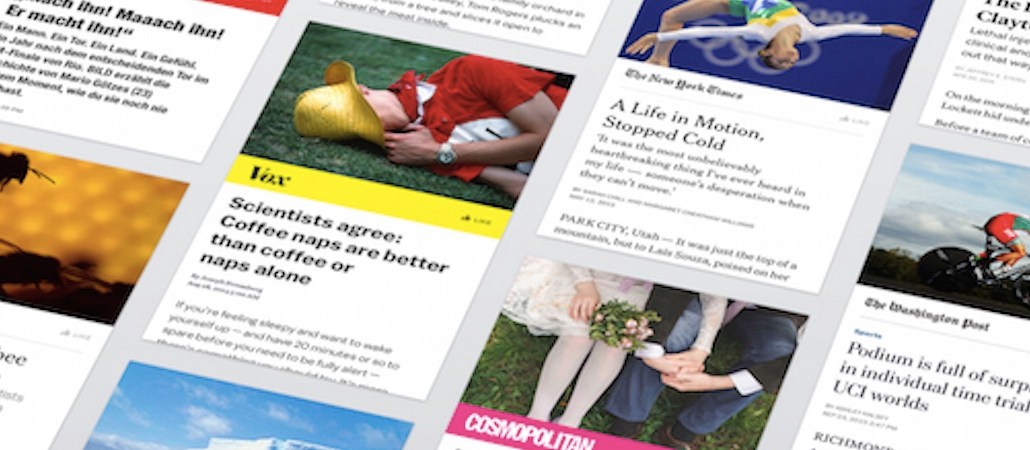Connect with execs from The New York Times, TIME, Dotdash Meredith and many more
‘It helps build that daily habit’: Publishers use Instant Articles bundle for daily must-reads

Publishers are using Facebook’s latest Instant Articles update, which lets publishers post multiple articles within one post, to publish regular editions of must-read content straight to the platform.
Since last week, 10 publishers — among them BuzzFeed, The Washington Post, The Sun and El País — have been testing out the new feature before a wider roll-out. “We can explore the opportunities beyond just a link,” said David Merrell, lead product manager at The Washington Post.
The Post will later experiment with timing and types of content; for now, it’s publishing a bundle of five must-read items each morning to Instant Articles. “When you wake up, the first thing you do is go on Facebook,” he added. “Rather than seeing a scattering of news articles, you’ll get the five most important articles right now.” It’s akin to receiving a daily email with the day’s top stories, but readers won’t have to leave Facebook to get it.
Building the daily habit
Once the reader has swiped through the articles, they see a message from Facebook saying, “You’re all caught up. We’ll see you tomorrow,” with the option to subscribe to get alerts when bundles are posted. “It helps build that daily habit. We want people to discover it, rather than push it down their throats,” said Merrell.

Getting publishers involved at this stage means they can thrash out the most useful ways of measuring engagement, and how and where new ad placements can be added. While there are new spaces for ad placement in the stack, the first priority is focusing on how readers respond.
Instant Articles ad revenue for The Washington Post has been “growing.” All revenue made from ads sold directly by The Post’s commercial team is kept by the publisher, while publishers keep 70 percent of Facebook sells for them. The Post’s unsold inventory is then sold by Facebook’s Audience Network. “We’ve found this to be very lucrative,” he said, thanks to the data that Facebook has to target these ads. This isn’t the story across the board, though: Publishers like The Independent report that yields have eroded since using the feature.
All of the Washington Post’s daily content, between 800 and 1,000 pieces, are available on Instant Articles. Facebook has previously said that Instant Articles are shared at a 15 percent higher rate than regular links posted to Facebook. The Post is seeing similar results. It measures success in stickiness, the likelihood a reader will return in a week. Before Instant Articles, 50 percent of people reading on Facebook came back within the next seven days, now it’s risen to 60 percent.
Fighting fake news
“For us, this is an amazing tool in order to fight fake news,” said David Alandete, managing editor, El País. “It’s a way of fighting the lies and intoxication. We can circumvent the algorithm and reach our audience directly.”
El País is also sending out a daily bundle of five of its best stories at 7 a.m., a mix of items including breaking news, opinion, in-depth reports and video. Because El País also publishes in Portuguese and Catalan, it can alter these items geographically depending on whether they’re going to readers in Brazil or northern Spain. “The mixture of the nature of Facebook’s location targeting and the positive disruption of Instant Articles brings us in new audiences by age range and geography,” Alandete told Digiday.
Since it started using Instant Articles last year, the Spanish newspaper pushes roughly 100 pieces this way each day, out of about 250. Despite being happy with the results, it has resisted publishing all articles to Instant Articles. In the coming months, however, it plans to go all in once the publisher’s commercial team has analyzed the advertising benefits.
“Instant Articles has doubled our Facebook traffic,” said Alandete. “In the last two years, we’ve seen at least 75 percent increase in all Facebook traffic,” he added, although, for the last year, regular Facebook traffic has been flat. Last December was the first time El Pais saw 50 percent of its traffic from regular Facebook links and 50 percent from Instant Articles.
Publishers we spoke to for this piece were happy with the relationship with Facebook, but there’s no getting away from the fact this is another adjustment. “Facebook has a history of changing the terms of such relationships without much notice,” said Susan Bidel, senior analyst at Forrester. “So we’ll have to wait and see how this rolls out.”
More in Media

Retail media meets publishing: News UK, Future and Ocado tap clean room tech for smarter data targeting
News UK, The Independent, Immediate Media and Future are teaming up with retail media network Ocado to test clean room-powered data matching.

From sidelines to spotlight: Esports events are putting creators center stage
Esports events’ embrace of content creators reflects advertisers’ changing priorities across both gaming and the wider culture. In the past, marketers viewed esports as one of the best ways to reach gamers. In 2025, brands are instead prioritizing creators in their outreach to audiences across demographics and interest areas, including gaming.

Condé Nast and Hearst strike Amazon AI licensing deals for Rufus
Condé Nast and Hearst have joined the New York Times in signing a licensing deal with Amazon for its AI-powered shopping assistant Rufus.








